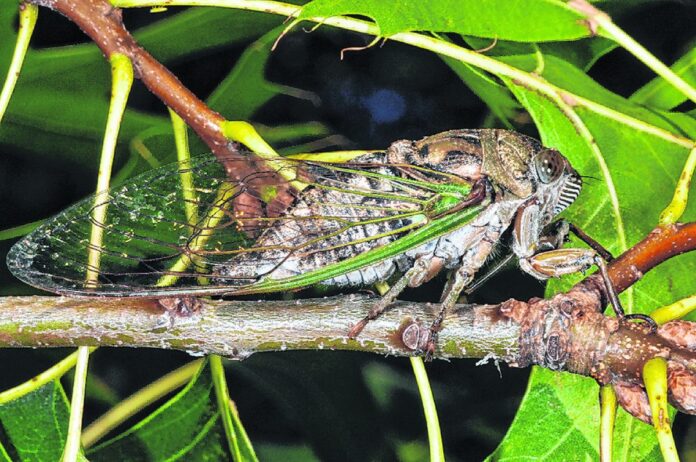By LESLIE BISHOP, guest columnist
This summer I am exploring the wilds of New Mexico. Desert life is a far cry from the familiar deciduous forests of my home in Indiana. Here, I wander among juniper and pinyon pine and am challenged daily by identifying unfamiliar wildflowers.
Yet today, as my dog and I hiked among the foothills near Santa Fe, I heard a familiar sound: the buzzing chorus of cicadas. This desert species of cicada links me to home, to the friendly sound of a hot Brown County summer day.
There are 170 species of cicadas in North America north of Mexico, with habitats ranging from the coastal scrub of California to the deserts of Arizona and New Mexico, and to the deciduous and coniferous forests of the Midwest and East Coast. Basically, if there are hot summers and shrubs or trees, there will be cicadas.
In Indiana, there are at least 20 species of cicadas. Of these there are two major types of life cycles, annual and periodical. Annual cicadas, called dog-days cicadas, emerge every year and are the signature sound of summer. These large, green cicadas with big, dark, bulging eyes and black wing veins sing from the trees until early fall. Even though annual cicadas take several years to develop, the generations overlap so that these cicadas emerge every year.
[sc:text-divider text-divider-title=”Story continues below gallery” ]On the other hand, cicada species with the periodical life cycle emerge synchronously after long periods of time. For example, in Indiana, the next emergence of the 17-year cicada — Brood X in the species Magicicada septendecim — will be in 2021. These cicadas have striking black bodies, red eyes and red wing veins. The periodical cicadas create the loudest choruses due to sheer numbers of individuals.
All the variety of cicada species share a common cycle. After mating, a female cicada inserts tiny, white eggs with her sharp ovipositor into a tree or shrub limb. Once the egg hatches, the small, white nymph will begin to feed on the tree fluids. After several growth stages, or molts, the young nymph will fall to the ground where it will excavate with front legs especially adapted for digging until it finds roots to feed on. The cicada nymph will stay underground, tunneling and feeding, from two to 17 years depending on the species.
After the long underground stage, cicada nymphs emerge and climb up the nearest available tree. There, they shed their nymph exoskeleton and unfurl their transparent, crumpled wings. Once their new wings emerge and exoskeleton hardens, they can begin their brief adult life looking for a mate. The males call, the females respond, they mate, and the life cycle begins again.
At times during the summer, the cicada chorus can be alarmingly loud. Male cicadas have two chambers on their abdomen covered with membranes (tymbals) that vibrate by contraction and relaxation of muscles to produce sound. One entomologist compared their bodies to guitars with air-filled spaces that act like resonating chambers that will amplify the sound. Both the male and female cicadas have auditory organs that receive sound.
The males produce a species-specific mating call, and only females of the same species will respond to that call. Some calls sound like shaking maracas, others like buzzing chain saws, and others like pulsating motors. And in a chorus, the males synchronize their calls into a rhythm from a low hum to an impressive crescendo.
As I spend this time far from Indiana in a high desert environment, I marvel at the differences as well as the similarities in the life of cicadas. The desert cicadas sing during the hottest time of the day. Biologists hypothesize that this strategy helps them avoid predators like snakes, lizards and birds that hide from the heat during this time.
To avoid overheating, these desert cicadas have a method of evaporative cooling where moisture is removed from their blood and is passed throughout ducts in their bodies to pores on their thorax — a type of sweating.
The sound of cicadas means summertime to me no matter where I roam!
Leslie Bishop is a Brown County resident and retired biology professor from Earlham College. She can be reached through the newspaper at [email protected].





